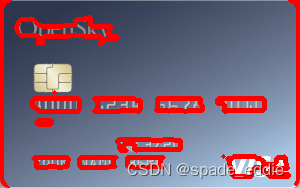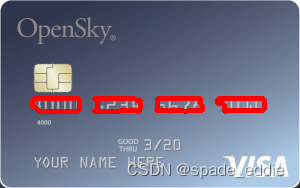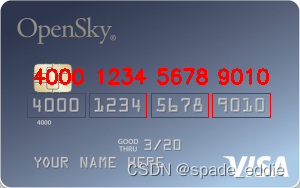一、项目描述
-
目的
识别信用卡中的卡号数字 -
输入与输出

-
方法流程
核心思想:采用模板匹配的方法,先保存每个数字模板,依次匹配感兴趣区域的数字对象,保留结果。具体流程如下:- 对模板图像进行外轮廓检测,从左到右排序得到每个数字的模板图像
- 对待识别的图像进行预处理,提取包含信用卡中感兴趣区域(包含文本信息的区域)
- 根据长宽比(先验知识)过滤掉不相关的轮廓。并进一步细分提取出每个待识别的数字,与之间的模板进行匹配
二、代码详解
2.1 预定义参数
-
导包
import os import cv2 import argparse import numpy as np from imutils import contours -
设置参数
- 图像路径参数
def parse(): """设置自己的参数""" parser = argparse.ArgumentParser(description="set your identity parameters") parser.add_argument("-i", "--image", default="./images", type=str, help="path to input image") parser.add_argument("-t", "--template", default="./ocr_a_reference.png", type=str, help="path to template OCR-A image") opt = parser.parse_args() # opt = vars(opt) # 可用于返回参数的‘字典对’对象 return opt- 信用卡类别参数
FIRST_NUMBER = { "3": "American Express", "4": "Visa", "5": "MasterCard", "6": "Discover Card" }
2.2 辅助函数
- 绘图
def cv_show(name, img): """绘图,避免重复造轮子""" cv2.imshow(name, img) cv2.waitKey(0) cv2.destroyAllWindows() - 轮廓排序(同imutils.contours.sort_contours())
def sort_contours(cnts, method="left-to-right"): """对轮廓进行排序""" # 设置标识 reverse = False # 表示排序是否需要反转:正序(左->右,上->下)为False 逆序(右->左,下->上)为True i = 0 # 表示按x轴排序还是按y轴排序:上下为1 左右为0 if method == "right-to-left" or method == "bottom-to-top": reverse = True if method == "top-to-bottom" or method == "bottom-to-top": i = 1 # 对轮廓进行排序。用一个最小的矩形,把找到的形状包起来x,y,h,w,按x或y进行排序 boundingBoxes = [cv2.boundingRect(c) for c in cnts] (cnts, boundingBoxes) = zip(*sorted(zip(cnts, boundingBoxes), key=lambda b: b[1][i], reverse=reverse)) return cnts, boundingBoxes - 缩放图像尺寸
def resize(image, width=None, height=None, inter=cv2.INTER_AREA): """根据自定的宽/高进行等比例缩放图像""" dim = None # 缩放后的图像尺寸 h, w = image.shape[:2] # 原始图像尺寸 if width is None and height is None: return image if width is None: r = height / float(h) dim = (int(w * r), height) else: r = width / float(w) dim = (width, int(h * r)) resized = cv2.resize(image, dim, interpolation=inter) return resized
2.3 模板图像处理
-
模板图像

-
主要步骤:
- 读取模板图像,并转换为灰度图
img = cv2.imread(opt.template) ref = cv2.cvtColor(img, cv2.COLOR_BGR2GRAY)
- 将模板图像的灰度图二值化
ref = cv2.threshold(ref, 10, 255, cv2.THRESH_BINARY_INV)[1]
- 寻找二值图中的每个外轮廓
refCnts, hierarchy = cv2.findContours(ref.copy(), cv2.RETR_EXTERNAL, cv2.CHAIN_APPROX_SIMPLE)
- 对所有外轮廓进行排序。从左到右,从上到下
refCnts = sort_contours(refCnts, method="left-to-right")[0]- 依次遍历每一个轮廓,并存储每个类别模板
digits = {} for i, c in enumerate(refCnts): (x, y, w, h) = cv2.boundingRect(c) # 计算轮廓的最小外接矩形 roi = ref[y:y + h, x:x + w] # 从二值图中提取当前类别模板 roi = cv2.resize(roi, (57, 88)) # 将模板resize到合适尺寸 digits[i] = roi # 存储当前类别模板 -
代码实现
def deal_template(opt): """预处理模板图像,将每个类别的模板图像保存在字典中""" img = cv2.imread(opt.template) # 读取模板图像 ref = cv2.cvtColor(img, cv2.COLOR_BGR2GRAY) # 将模板图像转换为灰度图 ref = cv2.threshold(ref, 10, 255, cv2.THRESH_BINARY_INV)[1] # 二值化模板的灰度图像 # ------------------------------------------------------- # cv2.findContours(): 寻找二值图中的轮廓 # 参数: # cv2.RETR_EXTERNAL: 只检测外轮廓 # cv2.CHAIN_APPROX_SIMPLE:只保留终点坐标 # 返回的list中每个元素都是图像中的一个轮廓 # 注:函数接受的参数为二值图,即黑白的(不是灰度图) # ------------------------------------------------------- refCnts, hierarchy = cv2.findContours(ref.copy(), cv2.RETR_EXTERNAL, cv2.CHAIN_APPROX_SIMPLE) # 查找模板中的每个外轮廓 cv2.drawContours(img, refCnts, -1, (0, 0, 255), 3) # 将轮廓绘制在原始图像上 print(np.array(refCnts, dtype=object).shape) # 打印轮廓的个数 refCnts = sort_contours(refCnts, method="left-to-right")[0] # 对轮廓进行排序。从左到右,从上到下 # 遍历每一个轮廓,并存储每个类别模板 digits = {} for i, c in enumerate(refCnts): (x, y, w, h) = cv2.boundingRect(c) # 计算轮廓的最小外接矩形 roi = ref[y:y + h, x:x + w] # 从二值图中提取当前类别模板 roi = cv2.resize(roi, (57, 88)) # 将模板resize到合适尺寸 digits[i] = roi # 存储当前类别模板 return digits
2.4 识别信用卡图像
-
信用卡图像

-
主要步骤
- 将待识别图像进行缩放并转换为灰度图
image = cv2.imread(img_path) # 读取待识别图像 image = resize(image, width=300) # 将图像根据指定宽进行缩放 gray = cv2.cvtColor(image, cv2.COLOR_BGR2GRAY) # 转换为灰度图像
- 对灰度图进行礼帽操作,突出更明亮的区域
tophat = cv2.morphologyEx(gray, cv2.MORPH_TOPHAT, rectKernel) # 礼帽操作,突出更明亮的区域
- 利用sobel算子进行x方向边缘检测(y方向效果不好),取绝对值并归一化
gradX = cv2.Sobel(tophat, ddepth=cv2.CV_32F, dx=1, dy=0, ksize=-1) # 检测x方向的边缘。ksize=-1相当于用3*3的核 gradX = np.absolute(gradX) # 取绝对值 minVal, maxVal = np.min(gradX), np.max(gradX) gradX = (255 * ((gradX - minVal) / (maxVal - minVal))) # 归一化 gradX = gradX.astype("uint8")
- 通过闭运算(先膨胀,再腐蚀)将sobel检测的文字边缘连在一起
gradX = cv2.morphologyEx(gradX, cv2.MORPH_CLOSE, rectKernel)
- 二值化图像,使用THRESH_OTSU自动寻找合适的阈值
thresh = cv2.threshold(gradX, 0, 255, cv2.THRESH_BINARY | cv2.THRESH_OTSU)[1]
- 对二值图像进行闭运算,合并连接区域
thresh = cv2.morphologyEx(thresh, cv2.MORPH_CLOSE, sqKernel)
- 查找二值图像中的轮廓
threshCnts, hierarchy = cv2.findContours(thresh.copy(), cv2.RETR_EXTERNAL, cv2.CHAIN_APPROX_SIMPLE) cnts = threshCnts cur_img = image.copy() cv2.drawContours(cur_img, cnts, -1, (0, 0, 255), 3)
- 根据先验长宽信息,保留符合识别区域的轮廓(区域的最小外接矩),并将轮廓从左到右排序
locs = [] for (i, c) in enumerate(cnts): # 计算矩形 (x, y, w, h) = cv2.boundingRect(c) ar = w / float(h) # 选择合适的区域,根据实际任务来,这里的基本都是四个数字一组 if 2.5 < ar < 4.0: if 40 < w < 55 and 10 < h < 20: # 符合的留下来 locs.append((x, y, w, h)) # 将符合的轮廓从左到右排序 locs = sorted(locs, key=lambda x: x[0])
9. 遍历轮廓中的每个数字,进行模板匹配output = [] # 保存所有的识别结果 for i, (gX, gY, gW, gH) in enumerate(locs): groupOutput = [] # 保存当前组(轮廓方框)的识别结果 # 根据坐标提取每一个组 group = gray[gY - 5:gY + gH + 5, gX - 5:gX + gW + 5] # 二值化 group = cv2.threshold(group, 0, 255, cv2.THRESH_BINARY | cv2.THRESH_OTSU)[1] # 计算每一组的轮廓 digitCnts, hierarchy = cv2.findContours(group.copy(), cv2.RETR_EXTERNAL, cv2.CHAIN_APPROX_SIMPLE) # 对当前组的所有轮廓从左到右排序 digitCnts = contours.sort_contours(digitCnts, method="left-to-right")[0] # 计算每一组中的每一个数值 for c in digitCnts: # 找到当前数值的轮廓,resize成合适的的大小 (x, y, w, h) = cv2.boundingRect(c) roi = group[y:y + h, x:x + w] roi = cv2.resize(roi, (57, 88)) # 计算匹配得分 scores = [] # 在模板中计算每一个得分 for digit, digitROI in digits.items(): # 模板匹配 result = cv2.matchTemplate(roi, digitROI, cv2.TM_CCOEFF) _, score, _, _ = cv2.minMaxLoc(result) scores.append(score) # 得到最合适的数字 groupOutput.append(str(np.argmax(scores))) # 画出来 cv2.rectangle(image, (gX - 5, gY - 5), (gX + gW + 5, gY + gH + 5), (0, 0, 255), 1) cv2.putText(image, "".join(groupOutput), (gX, gY - 15), cv2.FONT_HERSHEY_SIMPLEX, 0.65, (0, 0, 255), 2) # 得到结果 output.extend(groupOutput) # 绘制与打印结果 cv_show("Image", image) print("Credit Card Type: {}".format(FIRST_NUMBER[output[0]])) print("Credit Card #: {}".format("".join(output)))
-
代码实现
def template_math(img_path): image = cv2.imread(img_path) # 读取待识别图像 image = resize(image, width=300) # 将图像根据指定宽进行缩放 gray = cv2.cvtColor(image, cv2.COLOR_BGR2GRAY) # 转换为灰度图像 # 初始化卷积核 rectKernel = cv2.getStructuringElement(cv2.MORPH_RECT, (9, 3)) sqKernel = cv2.getStructuringElement(cv2.MORPH_RECT, (5, 5)) tophat = cv2.morphologyEx(gray, cv2.MORPH_TOPHAT, rectKernel) # 礼帽操作,突出更明亮的区域 gradX = cv2.Sobel(tophat, ddepth=cv2.CV_32F, dx=1, dy=0, ksize=-1) # 检测x方向的边缘。ksize=-1相当于用3*3的核 gradX = np.absolute(gradX) # 取绝对值 minVal, maxVal = np.min(gradX), np.max(gradX) gradX = (255 * ((gradX - minVal) / (maxVal - minVal))) # 归一化 gradX = gradX.astype("uint8") print(np.array(gradX).shape) # 通过闭操作(先膨胀,再腐蚀)将数字连在一起 gradX = cv2.morphologyEx(gradX, cv2.MORPH_CLOSE, rectKernel) # THRESH_OTSU会自动寻找合适的阈值,适合双峰,需把阈值参数设置为0 thresh = cv2.threshold(gradX, 0, 255, cv2.THRESH_BINARY | cv2.THRESH_OTSU)[1] # 再来一个闭操作 thresh = cv2.morphologyEx(thresh, cv2.MORPH_CLOSE, sqKernel) # 再来一个闭操作 # 计算轮廓 threshCnts, hierarchy = cv2.findContours(thresh.copy(), cv2.RETR_EXTERNAL, cv2.CHAIN_APPROX_SIMPLE) cnts = threshCnts cur_img = image.copy() cv2.drawContours(cur_img, cnts, -1, (0, 0, 255), 3) # 遍历轮廓 locs = [] for (i, c) in enumerate(cnts): # 计算矩形 (x, y, w, h) = cv2.boundingRect(c) ar = w / float(h) # 选择合适的区域,根据实际任务来,这里的基本都是四个数字一组 if 2.5 < ar < 4.0: if 40 < w < 55 and 10 < h < 20: # 符合的留下来 locs.append((x, y, w, h)) # 将符合的轮廓从左到右排序 locs = sorted(locs, key=lambda x: x[0]) # 遍历每一个轮廓中的数字 output = [] for i, (gX, gY, gW, gH) in enumerate(locs): # initialize the list of group digits groupOutput = [] # 根据坐标提取每一个组 group = gray[gY - 5:gY + gH + 5, gX - 5:gX + gW + 5] # 二值化 group = cv2.threshold(group, 0, 255, cv2.THRESH_BINARY | cv2.THRESH_OTSU)[1] # 计算每一组的轮廓 digitCnts, hierarchy = cv2.findContours(group.copy(), cv2.RETR_EXTERNAL, cv2.CHAIN_APPROX_SIMPLE) digitCnts = contours.sort_contours(digitCnts, method="left-to-right")[0] # 计算每一组中的每一个数值 for c in digitCnts: # 找到当前数值的轮廓,resize成合适的的大小 (x, y, w, h) = cv2.boundingRect(c) roi = group[y:y + h, x:x + w] roi = cv2.resize(roi, (57, 88)) # 计算匹配得分 scores = [] # 在模板中计算每一个得分 for digit, digitROI in digits.items(): # 模板匹配 result = cv2.matchTemplate(roi, digitROI, cv2.TM_CCOEFF) _, score, _, _ = cv2.minMaxLoc(result) scores.append(score) # 得到最合适的数字 groupOutput.append(str(np.argmax(scores))) # 画出来 cv2.rectangle(image, (gX - 5, gY - 5), (gX + gW + 5, gY + gH + 5), (0, 0, 255), 1) cv2.putText(image, "".join(groupOutput), (gX, gY - 15), cv2.FONT_HERSHEY_SIMPLEX, 0.65, (0, 0, 255), 2) # 得到结果 output.extend(groupOutput) # 绘制与打印结果 cv_show("Image", image) print("Credit Card Type: {}".format(FIRST_NUMBER[output[0]])) print("Credit Card #: {}".format("".join(output))) return output
三、项目完整代码
import os
import cv2
import argparse
import numpy as np
from imutils import contours
def parse():
"""设置自己的参数"""
parser = argparse.ArgumentParser(description="set your identity parameters")
parser.add_argument("-i", "--image", default="./images", type=str, help="path to input image")
parser.add_argument("-t", "--template", default="./ocr_a_reference.png", type=str,
help="path to template OCR-A image")
opt = parser.parse_args()
# opt = vars(opt) # 可用于返回参数的‘字典对’对象
return opt
def cv_show(name, img):
"""绘图,避免重复造轮子"""
cv2.imshow(name, img)
cv2.waitKey(0)
cv2.destroyAllWindows()
def sort_contours(cnts, method="left-to-right"):
"""对轮廓进行排序"""
# 设置标识
reverse = False # 表示排序是否需要反转:正序(左->右,上->下)为False 逆序(右->左,下->上)为True
i = 0 # 表示按x轴排序还是按y轴排序:上下为1 左右为0
if method == "right-to-left" or method == "bottom-to-top":
reverse = True
if method == "top-to-bottom" or method == "bottom-to-top":
i = 1
# 对轮廓进行排序。用一个最小的矩形,把找到的形状包起来x,y,h,w,按x或y进行排序
boundingBoxes = [cv2.boundingRect(c) for c in cnts]
(cnts, boundingBoxes) = zip(*sorted(zip(cnts, boundingBoxes),
key=lambda b: b[1][i],
reverse=reverse))
return cnts, boundingBoxes
def resize(image, width=None, height=None, inter=cv2.INTER_AREA):
"""根据自定的宽/高进行等比例缩放图像"""
dim = None # 缩放后的图像尺寸
h, w = image.shape[:2] # 原始图像尺寸
if width is None and height is None:
return image
if width is None:
r = height / float(h)
dim = (int(w * r), height)
else:
r = width / float(w)
dim = (width, int(h * r))
resized = cv2.resize(image, dim, interpolation=inter)
return resized
def deal_template(opt):
"""预处理模板图像,将每个类别的模板图像保存在字典中"""
img = cv2.imread(opt.template) # 读取模板图像
ref = cv2.cvtColor(img, cv2.COLOR_BGR2GRAY) # 将模板图像转换为灰度图
ref = cv2.threshold(ref, 10, 255, cv2.THRESH_BINARY_INV)[1] # 二值化模板的灰度图像
# -------------------------------------------------------
# cv2.findContours(): 寻找二值图中的轮廓
# 参数:
# cv2.RETR_EXTERNAL: 只检测外轮廓
# cv2.CHAIN_APPROX_SIMPLE:只保留终点坐标
# 返回的list中每个元素都是图像中的一个轮廓
# 注:函数接受的参数为二值图,即黑白的(不是灰度图)
# -------------------------------------------------------
refCnts, hierarchy = cv2.findContours(ref.copy(), cv2.RETR_EXTERNAL, cv2.CHAIN_APPROX_SIMPLE) # 查找模板中的每个外轮廓
cv2.drawContours(img, refCnts, -1, (0, 0, 255), 3) # 将轮廓绘制在原始图像上
print(np.array(refCnts, dtype=object).shape) # 打印轮廓的个数
refCnts = sort_contours(refCnts, method="left-to-right")[0] # 对轮廓进行排序。从左到右,从上到下
# 遍历每一个轮廓,并存储每个类别模板
digits = {}
for i, c in enumerate(refCnts):
(x, y, w, h) = cv2.boundingRect(c) # 计算轮廓的最小外接矩形
roi = ref[y:y + h, x:x + w] # 从二值图中提取当前类别模板
roi = cv2.resize(roi, (57, 88)) # 将模板resize到合适尺寸
digits[i] = roi # 存储当前类别模板
return digits
def template_math(img_path):
image = cv2.imread(img_path) # 读取待识别图像
image = resize(image, width=300) # 将图像根据指定宽进行缩放
gray = cv2.cvtColor(image, cv2.COLOR_BGR2GRAY) # 转换为灰度图像
cv_show("image", image)
# 初始化卷积核
rectKernel = cv2.getStructuringElement(cv2.MORPH_RECT, (9, 3))
sqKernel = cv2.getStructuringElement(cv2.MORPH_RECT, (5, 5))
tophat = cv2.morphologyEx(gray, cv2.MORPH_TOPHAT, rectKernel) # 礼帽操作,突出更明亮的区域
gradX = cv2.Sobel(tophat, ddepth=cv2.CV_32F, dx=1, dy=0, ksize=-1) # 检测x方向的边缘。ksize=-1相当于用3*3的核
gradX = np.absolute(gradX) # 取绝对值
minVal, maxVal = np.min(gradX), np.max(gradX)
gradX = (255 * ((gradX - minVal) / (maxVal - minVal))) # 归一化
gradX = gradX.astype("uint8")
print(np.array(gradX).shape)
# 通过闭操作(先膨胀,再腐蚀)将数字连在一起
gradX = cv2.morphologyEx(gradX, cv2.MORPH_CLOSE, rectKernel)
# THRESH_OTSU会自动寻找合适的阈值,适合双峰,需把阈值参数设置为0
thresh = cv2.threshold(gradX, 0, 255, cv2.THRESH_BINARY | cv2.THRESH_OTSU)[1]
# 再来一个闭操作
thresh = cv2.morphologyEx(thresh, cv2.MORPH_CLOSE, sqKernel)
# 计算轮廓
threshCnts, hierarchy = cv2.findContours(thresh.copy(), cv2.RETR_EXTERNAL, cv2.CHAIN_APPROX_SIMPLE)
cnts = threshCnts
cur_img = image.copy()
cv2.drawContours(cur_img, cnts, -1, (0, 0, 255), 3)
# 遍历轮廓,保留符合先验信息的轮廓
locs = []
for (i, c) in enumerate(cnts):
# 计算矩形
(x, y, w, h) = cv2.boundingRect(c)
ar = w / float(h)
# 选择合适的区域,根据实际任务来,这里的基本都是四个数字一组
if 2.5 < ar < 4.0:
if 40 < w < 55 and 10 < h < 20:
# 符合的留下来
locs.append((x, y, w, h))
# 将符合的轮廓从左到右排序
locs = sorted(locs, key=lambda x: x[0])
# 遍历每一个轮廓中的数字
output = []
for i, (gX, gY, gW, gH) in enumerate(locs):
# initialize the list of group digits
groupOutput = []
# 根据坐标提取每一个组
group = gray[gY - 5:gY + gH + 5, gX - 5:gX + gW + 5]
# 二值化
group = cv2.threshold(group, 0, 255, cv2.THRESH_BINARY | cv2.THRESH_OTSU)[1]
# 计算每一组的轮廓
digitCnts, hierarchy = cv2.findContours(group.copy(), cv2.RETR_EXTERNAL, cv2.CHAIN_APPROX_SIMPLE)
digitCnts = contours.sort_contours(digitCnts, method="left-to-right")[0]
# 计算每一组中的每一个数值
for c in digitCnts:
# 找到当前数值的轮廓,resize成合适的的大小
(x, y, w, h) = cv2.boundingRect(c)
roi = group[y:y + h, x:x + w]
roi = cv2.resize(roi, (57, 88))
# 计算匹配得分
scores = []
# 在模板中计算每一个得分
for digit, digitROI in digits.items():
# 模板匹配
result = cv2.matchTemplate(roi, digitROI, cv2.TM_CCOEFF)
_, score, _, _ = cv2.minMaxLoc(result)
scores.append(score)
# 得到最合适的数字
groupOutput.append(str(np.argmax(scores)))
# 画出来
cv2.rectangle(image, (gX - 5, gY - 5), (gX + gW + 5, gY + gH + 5), (0, 0, 255), 1)
cv2.putText(image, "".join(groupOutput), (gX, gY - 15), cv2.FONT_HERSHEY_SIMPLEX, 0.65, (0, 0, 255), 2)
# 得到结果
output.extend(groupOutput)
# 绘制与打印结果
cv_show("Image", image)
print("Credit Card Type: {}".format(FIRST_NUMBER[output[0]]))
print("Credit Card #: {}".format("".join(output)))
return output
if __name__ == '__main__':
# =================== 参数预处理 ===================
FIRST_NUMBER = {
"3": "American Express",
"4": "Visa",
"5": "MasterCard",
"6": "Discover Card"
}
opt = parse()
# ================== 模板图像预处理 ==================
digits = deal_template(opt)
# =================== 模板匹配 ==================
for basename in os.listdir(opt.image):
image_path = opt.image + "/" + basename
output = template_math(image_path)





















 9286
9286











 被折叠的 条评论
为什么被折叠?
被折叠的 条评论
为什么被折叠?








